#Marquesses of Bute
Text

The opulent Mount Stuart House on the Isle of Bute was unexpected. Recommended by the locals as a must see. Found out that this pleasure palace belonged the to Marquesses of Bute. The same family that used to live at the Cardiff Castle in Wales. The interior is just as whimsical and beautiful like Cardiff Castle. A lot of referrals to astrology and mysticisms. This is seen through its tinted-glass windows and symbolism in its architecture. The chapel within Mount Stuart House is white marble
#original photography#australian photography#photographers on tumblr#australian photographer#original photographer#travel photography#nature#travel#travel blog#Mount Stuart House#Isle of bute#Scotland#UK#architecture#gothic architecture#Marquesses of Bute#opulence#history#astrology#whimsical#white marble
4 notes
·
View notes
Text
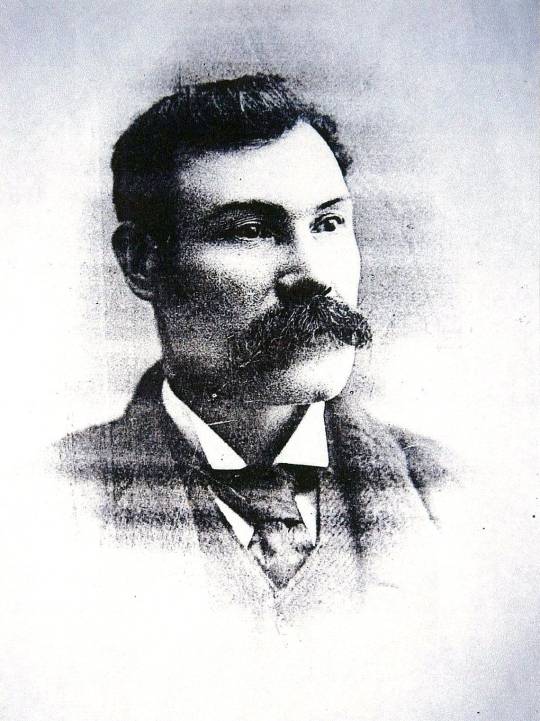

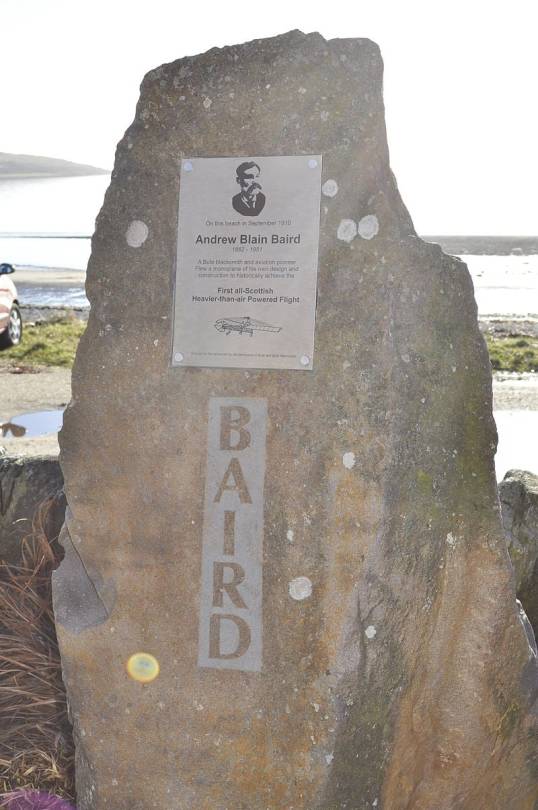
On 17th September 1910 Andrew Blain Baird, working as a blacksmith in Rothesay, made the first flight by an entirely Scottish designed and built aeroplane.
Andrew Blain Baird was born in 1862 in Sandhead on Luce Bay in the Rhinns of Galloway, Scotland. One of three sons, his father was a fisherman and handloom weaver. He became an apprentice to a blacksmith in Sandhead, worked as a lighthouse keeper on Lismore, then as an ironworker at Smith and McLean’s on the Clyde shipyards before finally setting up on his own as a blacksmith at 113 High Street in Rothesay, Isle of Bute, when he was 25.
Baird was a daring thinker, a pioneer and innovator. He created many improvements to the plough, built a unique model of the triple expansion engine powered by electricity and was one of the original members of the Scottish Aeronautical Society.
Eager to expand his knowledge of aviation, Baird corresponded with the early aviators Louis Bleriot and S. F. Cody and exchanged information about construction of aircraft and their flight. Inspired by a visit to Blackpool for England’s first ever Aviation Week in October 1909, he returned to Rothesay ready to design and build his own sophistocated monoplane similar to Bleriot’s but with an engine built by the Alexander Brothers in Edinburgh that was 4-cylinder, air-cooled and with water-cooled valves. The control system he would design for his aircraft would be unlike anything that had been developed at the time. His wife sewed brown trussore silk for the wings.
The Baird monoplane, once completed in his own shop in the summer of 1910, went on show at an exhibition in the Esplanade Flower Garden at the front of Bute. and then to the amazement and excitement of all it was moved to the Bute Highland Games on 20 August 1910.
From there it was taken for storage and readying directly to a barn owned by Willie Dickie at his farm at Cranlasgvourity, Bute.
Scottish aviation history was about to be made when in the very early morning of 17 September 1910, the Baird Monoplane was taken by a Mr Scott on his horse-drawn wagon to Ettrick Bay - with its wide expanse of sand reminiscent of the Kitty Hawk N.C. site chosen by the Wright Brothers for their historic flight.
In the sunshine and amid the wide golden sands of Ettrick Bay the first entirely Scottish designed and built plane sat ready to make history.
Andrew Baird was, on that day, assisted by his friend Ned Striven who was an Electrical Engineer with the Burgh of Rothesay and who had assisted him with the engine and related design considerations.
There on the wide expanse of Ettrick Bay beach, Baird and Ned Striven started the engine. All was ready. Hearts raced with anticipation. A small crowd looked on in amazement. And the flight into history began.
Flight Magazine on 24 September 1910,[1] described it as follows:
“Mr Baird was seated in the machine and on the engine being started the plane travelled along the sands at good speed. Naturally, on clearing the ground, the swerving influence of the axle ceased and the influence of the steering wheel brought the machine sharply round to the right causing it to swoop to the ground. The contact was so sharp that the right wheel buckled and the right plane suffered some abrasion by scraping along the beach.”
Andrew Blain Baird had realised his dream - he had flown in an aircraft of his own design and construction.
His was the first entirely Scottish flight of a heavier than air powered craft.
Noted pioneer aircraft manufacturer Tommy Sopwith sailed his yacht into Rothesay Bay in 1910 to visit the Marquess and to attend the Highland Games and there viewed the on display Baird monoplane. Very impressed, he was given permission to incorporate some of Baird’s innovations into the aircraft he was designing and which would have such a great impact on the course of World War I. Over the years, many others from around the world involved in aviation consulted Andrew Baird and learned from his pioneering experience and innovative mind.
12 notes
·
View notes
Text
Mount Stuart


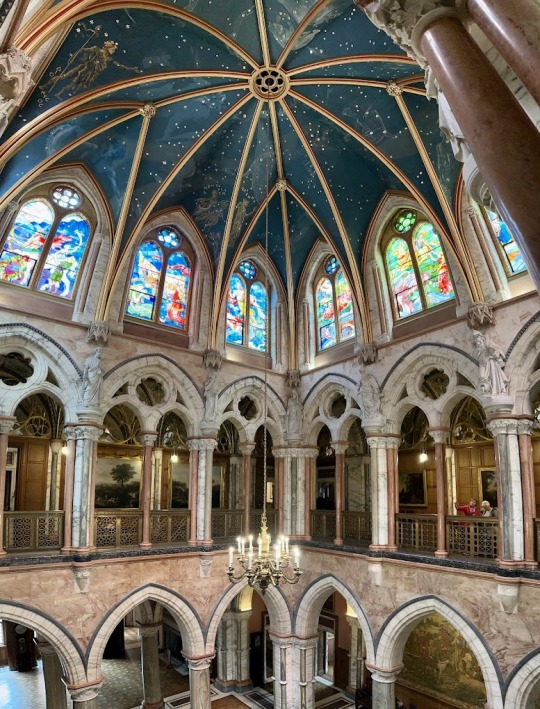
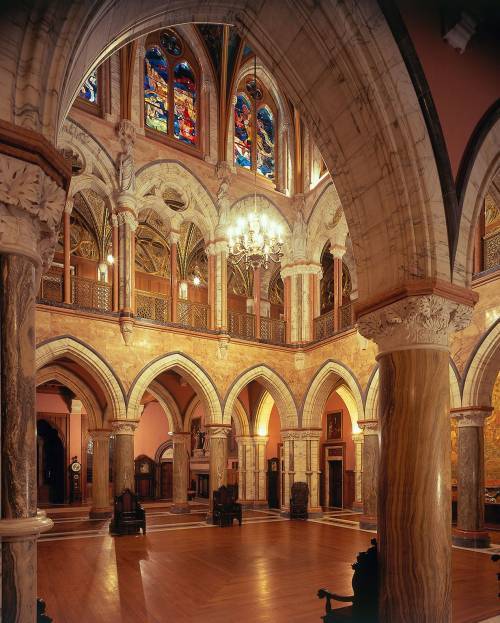
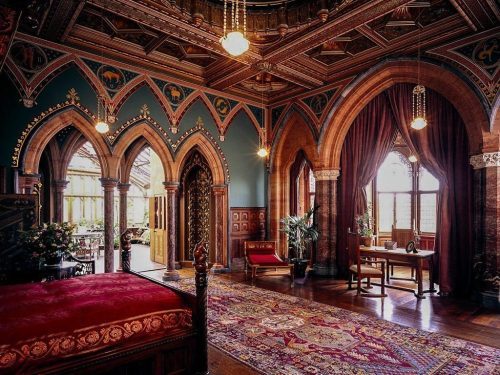
Mount Stuart is located on the east coast of the Isle of Bute in Scotland. The Gothic Revival country house was built in the 19th century. The house was built upon an earlier 18th century home severely damaged by a fire in 1877. The Georgian wings and much of the contents survived the fire and were incorporated into the new castle by the 3rd Marquess of Bute. The opulent interior boasts carved paneling, painted mirrors, a spiral staircase, a chapel, and much more. The Marble Hall has a map of stars on the ceiling and 12 stained glass windows depicting the signs of the zodiac moving through the seasons on the walls. The Gallery’s ceiling is decorated with winding branches from the Tree of Life, which frame the classical heads of 128 goddesses from ancient myth and legend. The house has collections of art and artifacts, including works by Ramsey, Reynolds, Gainsborough, as well as books, furniture, silverwork, porcelain, and Shakespeare’s First Folio. The estate has 300 acres of gardens that include a rock garden, a kitchen garden, an arboretum, and pinetums. The castle is used as a venue for weddings and corporate events. Mount Stuart can accommodate 37 guests in 22 separate areas around the house. There is a visitor center, a shop, and the Courtyard Café and Bakehouse.
21 notes
·
View notes
Text
Peerages & Titles: titles with territorial designations
[Full list of disclaimers is in the master post but tl;dr is that sources for this information are not consistent, sources may be modern, and this may be edited/expanded at anytime as my research continues.]
Some titles, more common contemporarily, include territorial designations. For example, the former prime minister Margaret Thatcher’s full title was Baroness Thatcher, of Kesteven in the County of Lincolnshire.
It is incorrect to omit any part of the territorial designation unless you omit all of it. Baroness Thatcher is fine, Baroness Thatcher of Kesteven is not; but the latter may be used informally.
This style of title is more common for barons and viscounts.
Anthony could be The Viscount Bridgerton, of Aubrey in the County of Kent (he is not, I don’t even think Aubrey is a place).
Given earls, marquesses and dukes typically have of in their title anyway, the territorial designation is typically before a comma within the title ie: The Duke of Hastings. However, it is still possible.
This is not his title, and rules differ slightly in Scotland anyway, but an example of what John’s title could be as an earl is The Earl Stirling, of Kilmartin in the Shire of Argyll and Bute.
This was raised by the question of Polin’s baby, here, who has a different last name to title. [Using Thomas for examples because that’s their first son in the books, but actually we have no idea what his name is and I’m mad]. He is Thomas Bridgerton, Baron Featherington.
Other examples of differing titles and names in the bridgerverse include John Stirling, The Earl of Kilmartin and Simon Bassett, The Duke of Hastings.
I cannot find confirmation of if/when such for uses of the name—rather than title—would be appropriate, especially in regency England, but I would think only possibly verbal reference and verbal introduction. I would hazard a guess that it would never be appropriate for a duke, and probably not a marquess or earl either.
Link to the master post here, hope this was helpful or at the very least interesting. Drop any questions in my ask :)
–GW xo
P.S. it is far from complete but I’ve started actually saving my sources like a rational human, so might be able to deliver a source list soon.
#writing#fanfic#writers of tumblr#bridgerton spoilers#bridgerton#bridgerton fanfiction#bridgerton fic#downton abbey#qcabs fanfiction#writing help#writing tips#historical fiction#fanfic help#fanfic tips#titling rules#titles#how to write english peers#peerages & titles#honorifics#forms of address#aristocracy#nobility#ask me about my hyperfocus
5 notes
·
View notes
Text
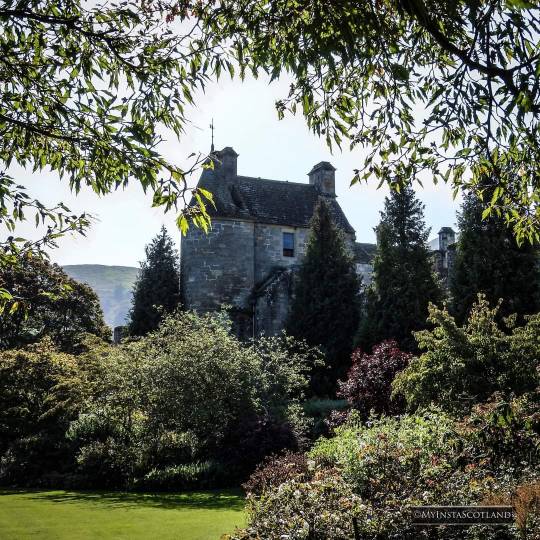
Falkland Palace, Fife.
Inspired by the grand châteaux of France, in the 16th century James IV and his son, James V, transformed this favoured retreat of the royal Stuarts – the palace became one of the finest examples of Renaissance architecture in Scotland.
One of Falkland’s most famous royal residents – Mary, Queen of Scots – was enchanted with the palace, and took advantage of Falkland’s vast estate to pursue falconry and hunting, while also enjoying a game of tennis in what is now the oldest surviving real (or royal) tennis court in the world.
Although it fell into disrepair after 1660, Falkland Palace was saved from ruin in the 19th century by the 3rd Marquess of Bute. The National Trust for Scotland is taking care of the palace today.
Did you know?
Johnny Cash played a televised concert at Falkland in 1981.
#fortheloveofscotland
#falklandpalace #nationaltrustforscotland #fiftyshades_of_history #loves_scotland #monumental_world #visitscotland #scotland #scotlandlover #scotland_greatshots #scotlandexplore #castles_oftheworld #loves_united_castle #ig_scotland #igscotland #insta_scotland #instascotland #lovescotland #thisisscotland #wonderlustscotland #hiddenscotland #castlesofscotland #amazingshots_castle #bestcastles #yourcastles #yourscotland
4 notes
·
View notes
Text
Early on the morning of 29 August 1930, the last 36 residents began the evacuation from St Kilda, a group of islands 110 miles off the west coast of Scotland that had been lived on for thousands of years.
Three hours later, 13 men, 10 women and 13 children were aboard the ship that would take them away from their homes forever.
They left because they were concerned they would not last another winter on the barren North Atlantic archipelago, which was virtually cut off from the mainland for nine months of the year by rough seas and winds.
The islanders’ precarious existence was already well known to the Secretary of State and his departmental officials, as well as to local government officials. His response to the petition was to organise the evacuation of all the islanders and most of their 1,500 sheep. On 29 August 1930 they were evacuated on HMS ‘Harebell’. Officials found forestry work for the men, and most of them were settled at Lochaline near Oban, while other families went to live at Strome Ferry, Ross-shire, Culcabock near Inverness, and at Culross, Fife.
At the time of the evacuation, St Kilda was owned by Sir Reginald MacLeod of MacLeod. The Earl of Dumfries bought the island as a bird sanctuary in 1931. He became the Marquess of Bute and at his death in 1956 bequeathed it to the National Trust for Scotland. In 1986 St Kilda became Scotland’s first World Heritage Site. Years after the evacuation, St Kilda was used for radar installations, and its archaeology has been extensively investigated and recorded. These contrasting activities are also documented in NRS records.
0 notes
Text





Wales (2) (3) (4) (5) by d0gwalker
Via Flickr:
(1) One of a series of animal sculptures on the wall separating Bute Park from Castle Street in Cardiff. The bear is one of the original sculptures created in the 1890s for the 3rd Marquess of Bute.
(2) Bike stands outside the entrance building of St Fagans National Museum of History, Cardiff. Designed by architect Dale Owen of Percy Thomas Partnership and built 1968-74.
(3) School of Biosciences, Cardiff University. Part of the Sir Martin Evans Building.
(4) (5) Part of the late 19th century gothic revival renovations undertaken for the 3rd Marquess of Bute by architect William Burges. The Arab Room was completed in 1881 and is decorated in the Moorish style, with a gilded ceiling reminiscent of the Alhambra in Granada. The Banqueting Hall is decorated with scenes from the castle's medieval history.
1 note
·
View note
Text

Henry ‘Chips’ Channon: The Diaries (Vol. 1), 1918-38, entry for 21st September 1923
—
Friday 21st September
Duntreath Castle¹
We motor eighty miles every day to Ayr races, usually in a downpour of rain. Ayr is my favourite meeting, it is so detached and different from the others. Oddly enough it is fashionable especially when the Scottish Derby is run. The members of the Caledonian Club appear in pink coats and top hats, Lord Bute² has a private tent and Lord Lonsdale's³ party arrive in yellow phaetons with outriders. Today⁴ we went to Buchanan⁵ to the Montroses'⁶ for tea. [It is] a glorious position for a castle with a wonderful view of Loch Lomond. The castle itself has been rebuilt recently with the old stone. The exterior has a look of Glamis,⁷ but the interior is frankly barbarously Victorian with paper lampshades. The Duchess is stately and very beautiful, though easily 65.⁸ She was a Graham and is an old friend . . . will she be my aunt I wonder? There were several masculine-looking daughters about, including the one married to the Cameron of Lochiel,⁹ with a flock of perfect children all in kilts and safety pins. The Duke showed us relics of the Great Montrose¹⁰ . . . but conversation was difficult, only grouse and the weather being mentioned.
—
At Blanefield in Stirlingshire, seat of the Edmonstone family.
John Crichton-Stuart (1881-1947), by courtesy Earl of Dumfries until 1900, when he succeeded his father as the 4th Marquess of Bute.
Hugh Cecil Lowther (1857-1944) succeeded his brother as the 5th Earl of Lonsdale in 1882, and squandered the family fortune. He was known as 'the Yellow Earl' because of his fondness for the colour. He was the first President of the Automobile Association, which adopted the colour for its livery.
Presumably Saturday 22nd September.
Buchanan Castle, near Drymen in Stirlingshire.
Douglas Beresford Malise Ronald Graham (1852-1925), by courtesy Marquess of Graham until 1874, when he succeeded his father as 5th Duke of Montrose. He married in 1876 Violet Hermione Graham (1854-1940).
Glamis Castle, in Angus, Scotland, seat of the Earl of Strathmore and Kinghorne.
She was 69.
Colonel Walter Cameron of Lochiel (1876-1951), 25th Chief of Clan Cameron, had married Lady Hermione Emily Graham (1882-1978) in 1906.
James Graham (1612-50), 1st Marquess of Montrose, was a hero of the Royalist side in Scotland during the Civil War. He was hanged and his head placed on a stake in Edinburgh, but he was rehabilitated after the Restoration.
#on this day#a century ago#1923#1920s#channon diaries#chips channon#john bute#hugh lonsdale#douglas montrose#violet montrose#hermione cameron#walter cameron#🕰️#didn't queue this one and nearly forgot to post it!#i know you all would've been devastated lol
0 notes
Photo

Cycled up to Castell Coch with my brother the other day. As beautiful a building as it is, I’m feeling torn up by history recently. Could the Marquess of Bute have contributed something that would’ve have benefited the city more than castle renovations? #castellcoch #rivertaff #rivertaffcardiff #afontaf #cardiff #caerdydd #tafftrail #history (at Castell Coch) https://www.instagram.com/p/CpsGN-iIzdj/?igshid=NGJjMDIxMWI=
0 notes
Photo

Quick Details Carriage Type Invalid Carriage Date of Production late 19th century Accession or Inventory Number ARL/CM/W/2 Materials used Paint, Wood, Iron, Leather, Wool Box Cloth, Brass Summary of Invalid Carriage Built by J. Ward of Leicester Square, London, this carriage, painted in the colours of the 6th Marquis of Bute, would appear to have been specially built to accommodate an invalid chair, which can be wheeled into it up a hinged ramp at the back. The wheels are no longer fitted to the chair. A small pony, driven by the invalid, would draw the carriage. The wrought iron shafts are, unusually, in the shape of a wishbone. Dimentions body of the carriage Height: 45 ins Length: 83 ½ ins Width: 48 ½ ins Front wheel diameter: 18 ½ ins Rear wheel diameter: 32 ¼ ins Full description This invalid carriage has a very low body with a straight bottom line that is only 7 ins above the ground. The tailboard is panelled with hinges at the bottom. The chair has a cut-under body and is of curved form with a hinged back rest, the angle of which can be controlled by two knobs. There are fittings for an adjustable footrest which is missing. With the wheels and axle removed the chair fits into the body of the carriage. The wheels on the carriage are 8 and 10 spoke English pattern with solid rubber tyres. The wheels and axle of the chair are missing. The carriage has grease axles of a type peculiar to invalid carriages. The front axle compassed is up and the hind axle cranked down by approximately 10 ½ ins with brass axle caps. The carriage is sprung on elliptic springs in front with no springs behind. The forecarriage is iron with a scrolled transom and a horn bar attached to curved stays from the front of the body. The axle bed reflects the shape of the transom. A lug is attached to the bottom wheel plate to carry the iron wishbone shafts (missing). The body of the carriage is possibly painted dark blue but the colour is concealed beneath the decayed varnish. The wheels and forecarriage are in dark blue and lined with yellow. The chair has the same colour scheme with fine yellow lines. On the chair on both side panels is a monogram of CB beneath a Marquess coronet. The inside surfaces of side panels are covered with padded and buttoned leather cloth with stitched seams in the shape of a wheel. The invalid chair has dark blue edging laces around all the inside edges. The chair has a leather dashboard with remains of leather serving on the mounting handles and the rein rail. Side squabs, arm rests and a seat rack are of buttoned dark brown morocco leather. The sprung seat cushion is upholstered in dark brown leather cloth and the seat fall is in dark brown morocco leather. Seaming and pasting laces are in dark blue wool cloth. The patterned floor cloth with a stencilled pattern is very deteriorated. Ivory knobs to attach an apron. Inscriptions On the axle caps: J.WARD*LEICESTER SQUARE * LONDON On a label underneath the seat: By her majesties Royal letters Patent and by Royal Appointment To her Majesty and the Royal Family & to the Empress of Austria, Russia, France & ? John Ward ?Leicester Square& 12 Leicester ? London Manufacturer of every kind of CHAIR, CARRIAGE, ANDBED For the Use & comfort of Invalids No. ? “Established more than a century” Condition report The invalid carriage is in original condition retaining its paintwork and leather upholstery.
https://www.thecarriagefoundation.org.uk/item/invalid-carriage
0 notes
Text
The Immediate Sparks of the Merthyr Rising
Most, if not all, events have a series of complex causes behind them with some long terms ones that have been bubbling beneath the surface for months even years and short term ones in that cause an almost immediate effect. The careful balance of these two help to create the basis for many riots, protests and rebellions. The Merthyr Rising is no exception to that.
The more long term causes of the riots can be found here. There will be some overlap between these causes.
The Reform Bill Crisis of 1830-32
The Reform Bill crisis surrounds the events of the Merthyr Rising, quite literally with the rising occurring in May and June of 1831. As has already been discussed in the long term causes, the political system in Britain at this time was outdated and broken with the urbanisation that came with the Industrial Revolution increasing these problems. I will not be delving into the complexities of the Reform Bill Crisis as this could be a whole series of posts on its own.
Anyway, many middle class individuals resented the political system. They were often richer than the upper class elite and contributed greatly to the economy of Britain, yet they did not have the vote. As the work force became more urbanised they also became more politicised and wanted the system to be changed in their favour. These joint demands led to a form of alliance between the middling orders and the workers which put great pressure on the ruling elite. Many of those in the middling orders were capable of leading rebellion on a scale which was far too familiar to the British observing events across the channel. in 1830 France had another revolution with the fall of Charles X. This led to fears that the same could happen on British soil.
In March 1831 the new Whig government under Lord John Russel introduced the First Reform Bill. Its content was unsatisfactory to the working classes but it was a step in the right direction. While it managed to pass through its second reading at the House of Commons it failed at the committee stage. The failure lead to the government calling an election in April 1831. Parliament was dissolved for the campaigning period and the Whigs were returned to government. A Second Reform Bill was created in the summer of 1831 which also failed. It wasn’t until a third Bill was introduced the next year that the Great Reform Act was passed. But we have moved passed the time frame of the Merthyr Rising.
The failure of the First Reform Bill caused widespread discontent amongst radicals many of whom were operating in and around the Merthyr area. Their ranks extended across social boundaries with workers and iron masters alike supporting the need for reform. They were already disappointed when the realised workers would not get a look in and Merthyr was not going to have a MP. The ironmasters were supportive of these ideas, wanting a MP to stand for Merthyr, hoping that they could be the one to fill that space .But the failure of the Bill furthered their discontent. Merthyr was not alone in this. The Reform Crisis gripped the nation, many towns facing protests and riots throughout the period.

Above is John Josiah Guest, the Ironmaster at Dowlais Ironworks. He married into the English aristocracy. His wife, Lady Charlotte Guest, had a great impact on Welsh culture, taking upon herself to learn Welsh and translate the Mabinogion, a series of Welsh folklore stories, into English.
Below is William Crawshay II the Ironmaster at Cyfarthfa Ironworks. He was known as the ‘Iron King’ and was responsible for building Cyfarthfa Castle, a manor house replicating the revived Gothic Style. It overlooked his ironworks so that he was close enough in case he was needed and so that he would not miss a beat relating to his ironworks. You can read more about Crawshay and Cyfarthfa Castle (here).

23 May 1831
The depression of the iron industry caused economic hardship in Merthyr and many other iron dependent towns. Crawshay, the iron master at the Cyfathfa Ironworks tried his best to ensure production could continue and his workers received fair pay. He stockpiled the iron in order to sell when demand and prices increased. He was part of the more paternalistic employers who wanted to ensure that their workers were well provided for with good jobs to see them through the hard times.
However, this could not go on forever as the workers found out on 23 May. Crawshay sacked 84 of his puddlers in order to try and revive his ironworks. Theses were highly skilled, highly sought out workers. They were essential in the iron making process in order to ensure the iron was strong. Their practise was considered a kind of industry secret with even the iron masters unfamiliar with exactly how they workes. Due to this their jobs were not just well paid for their skilled labour but also their were considered to be relatively safe. A feeling of panic grew among the workers. Suddenly nobody's job seemed safe. It was thought that if Crawshay could afford to let off 84 of his puddlers then he could certainly afford to let off even more of his less skilled workers. Wages of those who remained were also cut.
30 May 1831
A mass meeting was organised to discuss reform at Twyn-y-waun near the Dowlais works. But reform was not their only concern. Rather some of the long term causes behind the Merthyr Rising were discussed.
The depression in the iron industry had led to workers received less pay or even being let off. Many other employers in the area were not as thoughtful of their workforce as Crawshay, letting off workers as soon as the tide began to turn. This was coupled with a rising cost of living. Prices of necessities and rent had gone up while their wages had gone down. This was the case for those paid with traditional money and those paid through the Truck System. Prices in the company shops had increased even though they were being paid less tokens for their work. This left many in a dire situation on both sides.
In the difficult times, shopkeepers often had little choice but to increase their prices in order to provide for themselves and their own families. When workers couldn’t pay items could be taken on tab to be paid for when they recieved their wages. However, debts were quickly built up with tabs the shopkeepers could no longer afford to keep open. Shopkeepers also faced the repercussion of the depression in the iron industry with their customers unable to pay. They pressed for debts to be paid for them, the Court of Requests stepping in to collect them. The Court of Requests was also discussed at the mass meeting. The Court of Request was set up in 1809 to ensure the payment of small debts. Bailiffs were given the power to seize goods worth the equivalent price of debts. This causes widespread resentment, so much so that even the Marquess of Bute spoke out against them.
Their final grievance, as previously stated, was Crawshay letting go of some of his workforce and reducing the pay of those who remained. This was something Crawshay had desperately tried to avoid leading to this being unfamiliar territory to those who worked at the Cyfathfa Ironworks. If jobs were no longer safe there, then they were not safe anywhere.
31 May 1831
The rising begins.
#merthyr#merthyr tydfil#merthyr rising#19th Century#wales#welsh history#lady charlotte guest#john josiah guest#william crawshay ii#cyfarthfa#cyfarthfa castle#dowlais#great reform act#british political history#british social history#political history#social history#reform bill crisis#marquess of bute#lord john russel
6 notes
·
View notes
Text


On 25th June 1887 The Marquess of Bute unveiled the statue of William Wallace. on the National Wallace Monument.
The work of D. W. Stevenson of Edinburgh, this magnificent 6.4 metre bronze statue weighs 3 tons, a Baltimore financier called William Wallace Spence was that taken by the statue he got Stevenson to sculpt another which sits in Druid Hill Park in the city.
The pics are my own from March 2021.
#scotland#scottish#stirling#abbey craig#sir william wallace#william wallace national monument#history
15 notes
·
View notes
Photo



The Three Greek Fates as depicted by William Burges in a chimney piece designed as part of the Gothic style interior design work he did for the Castell Coch in Cardiff, then owned by John Patrick Crichton Stuart, the 3rd Marquess of Bute.
#The three greek fates#greek myths#ancient greece#William Burges#Castell Coch#Clotho#Lachesis#Atropos#fate#life#cycle of life#the three ages of man#John Patrick Crichton Stuart the 3rd Marquess of Bute#Cardiff#gothic
135 notes
·
View notes
Text
Hey everyone, I'll try not to ruin the mood, but let's remember all those amazing people whom we lost in 2021:
- Murray Walker, legendary former F1 commentator 1976-2009 (10.10.1923-13.03.2021)

- Max Mosley, former FIA president 1993-2009, lawyer and former racing driver (13.04.1940-23.05.2021)

- Jason Dupasquier, Number 50, Moto3 rider (07.09.2001-30.05.2021)

- Hugo Millán, Number 44, European Talent Cup rider (2006/7-24.07.2021)

- Carlos Reutemann, former F1 driver, 12x winner (12.04.1942-07.07.2021)

- Sir Frank Williams, founder of Williams Formula One Team (16.04.1942-28.11.2021)

- Nathalie Maillet, former Director of the Circuit de Spa-Francorchamps (11.05.1970-15.08.2021)

- Ádrian Campos, former F1 driver and founder of Campos Meta Formula One Team and Campos Racing (17.06.1960-28.01.2021)

- Fausto Gresini, 2 times Grand Prix motorcycle racing champion and former manager of the Aprilia Racing Team Gresini MotoG team (23.01.1961-23.02.2021)

- Dean Berta Viñales, Supersport 300 World Championship rider (20.04.2006-25.09.2021)

- John "Johnny" Colum Crichton-Stuart, 7th Marquess of Bute, aka Johnny Dumfries, former F1 driver (26.04.1958-22.03.2021)
- Bobby Unser, former F1 driver, 3 times Indy 500 winner (02.20.1934-02.05.2021)
- Al Unser, former F1 driver, 4 times Indy 500 winner, brother of Bobby Unser (29.05.1939-09.12.2021)
- Nino Vaccarella, former F1 driver, winner of the 1964 24 Hours of Le Mans (04.04.1933-23.09.2021)
They may be gone, but they won't be forgotten! 🕊🕯
#charles leclerc#max verstappen#lando norris#pierre gasly#lewis hamilton#sebastian vettel#i tagged some f1 drivers so more people see it please don't be mad#formula 1#f1#f1 2021#motogp#murray walker#max mosley#jason dupasquier#hugo millan#hugo millán#carlos reutemann#sir frank williams#nathalie maillet#adrian campos#fausto gresini#dean berta vinales#johnny dumfries#al unser#bobby unser#nino vaccarella#gone but never forgotten#rest in peace
119 notes
·
View notes
Text

Before the invention of Animal Crossing you just had to buy yourself an actual island.
Image: A photo of the sun setting over the sea, and seagulls flying close to the waves. At the centre of the image text reads: In 1931, soon after the archipelago was evacuated, St Kilda was sold to the Marquess of Bute, who was interested in acquiring the land due to a passion for ornithology. 26 years later it then became a National Trust site. In the bottom right corner is the St Kilda logo. End.
11 notes
·
View notes
Photo


I...I just...I just have a lot of ceilings
Seriously though. This is the ceiling at Cardiff Castle. Well, the Victorian-era Gothic revival manor house part of it, anyway (There’s also an 11th century motte and bailey, bits of a 3rd century Roman fort, and a military museum, all within a curtain wall in central Cardiff!). Generally, it’s considered to be one of the prettiest houses done in this style in the UK, thanks to the third Marquess of Bute, the owner, and William Burges, the architect and designer. The Victorians were like...super weirdly into romanticising the medieval period, and it shows. The Victorians were kinda weird generally, but they were really, really into Middle Ages motifs in their architecture and....questionable interior design choices. It’s a really cool visit, if you’re ever in the area!
#castle#cardiff#cardiff castle#ceiling#victorians#victorianstyle#they thought they were being edgy#and cool#why were they like this#William burges#gothic revival#ceiling pic#i just think they're neat
11 notes
·
View notes